WATER, HUMAN DIGNITY AND SOCIAL EQUITY
Chan Ngai Weng, PhD
President, Water Watch Penang
Professor, Universiti Sains Malaysia
Email: nwchan@usm.my
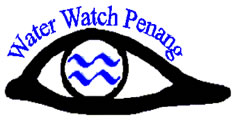
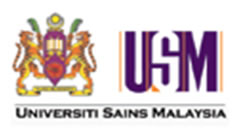
http://www.waterwatchpenang.org http://www.usm.my
Contents of Lecture
2.0 Philosophical/conceptual model of Values-based Water Education
2.1 Introduction on water as a basic human need
2.2 Introduction on water as a human right and economic good
2.2.1 Water as a human right
2.2.2 Water as an economic good
2.3 Role of water in determining social equity and human dignity with discussion on the philosophical/conceptual model for Values-based Water Education
3.2 Management of water resources with the roles and involvement of governmental and non-governmental organizations
3.2.1 Water resources management models: State centred, private sector driven and public-private-partnerships
(i) State Centred Model (wholly owned and managed by the state, or otherwise known as “Government Managed Model”);
(ii) The Privatisation Model
(iii) Public-Private Partnership Model
(iv) Community Managed Model
3.2.2.2 The roles of non-governmental organizations with exemplary practices and research findings
4.0 Conclusion
2.1 Introduction on Water as a Basic Human Need
Maslow’s Pyramid of Human Needs (1943)
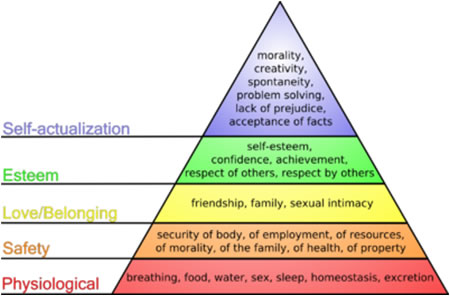
Figure 1: Maslow's hierarchy of needs, represented as a pyramid with the more primitive needs at the bottom (Source: Maslow, 1943).
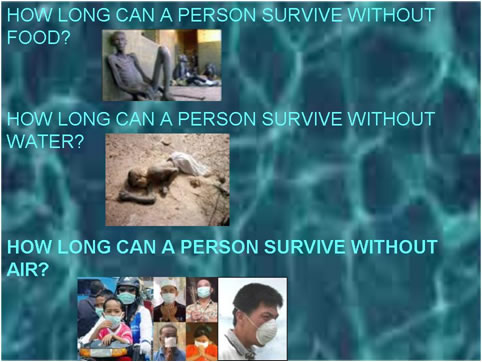
The Irony of Human Development and Progress
•Human society has made great progress
•Space Exploration
•Air Travel
•ICT
•Humans can trek, speak & watch each other remotely, and play God


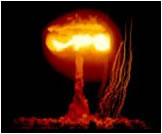
How Much Water Does A Human Need?
•1977 UN Water Conference - "All peoples have the right to have access to drinking water in quantities & quality equal to their basic needs“
•No life without water
•Direct Need - 5 litres of water per day needed to sustain our bodies
•Indirect Need - Indirectly, almost all other human needs depend one way or another on water
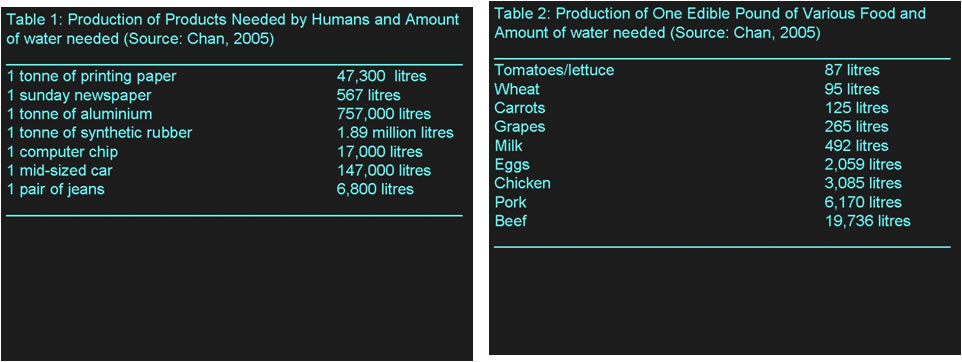
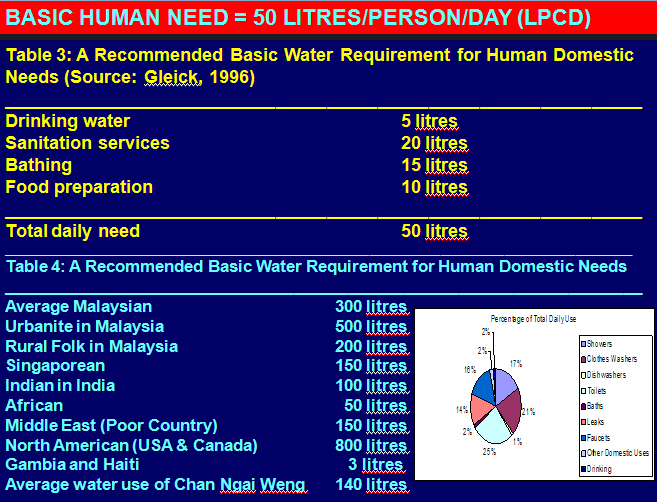
2.2 Introduction on water as a human right & economic good
2.2.1 Water as a human right
•Human rights = universal rights
•Human rights = international norms that help to protect people
•Human rights exist in morality & in law at the national & international levels
•A “right” is defined as the legal or moral entitlement of a person to do or refrain from doing something, or to obtain or refrain from obtaining an action, thing or recognition in civil society
•A right is a privilege, or something to which one has a just claim
Water as a human right (cont)
•A person has a right to life – this means others do not have the liberty to take away a life (or to kill)
•A person has a “Right to water” or “Water is human right”
•The Universal Declaration of Human Rights (UDHR) was adopted by the UN General Assembly on 10 Dec 1948 in Paris
•Issue of whether individuals or groups have a legal right to a minimum set of resources (e.g. water), & whether there is an obligation for states or other parties (e.g. water company) to provide those resources is still debated
TABLE 5: SELECTED HUMAN RIGHTS LAWS, COVENANTS AND INTERNATIONAL AGREEMENTS
1948 Universal Declaration of Human Rights (UDHR)
1950 European Convention on Human Rights (“Convention for the Protection of Human Rights and Fundamental Freedoms”)
1966 International Covenant on Economic, Social and Cultural Rights (ICESCR)
1966 International Covenant on Civil and Political Rights (ICCPR)
1986 Declaration on the Right to Development (DRD)
1989 Convention on the Rights of the Child (CRC)
1990 Convention on the Rights of all Migrant Workers (Source: Gleick, 2000:4)
1993 Vienna Declaration
•1992 - McCaffrey “..there is a right at least to sufficient water to sustain life” and that a state has the “..due diligence obligation to safeguard these rights.”
• 1999 Gleick - international law, international agreements, and practice of states strongly and broadly support the human right to a basic water requirement
• “Implicit” is not sufficient to create the obligations
• Necessary to translate implicit rights into explicit human right
•Legislation is needed
The United Nations Committee on Economic, Cultural and Social Rights (UNCECSR) Declaration, 27 November 2002
•27.11.2002 - “Water is fundamental for life and health”
• UN has taken the unprecedented step of agreeing on a “General Comment” on water as a human right
• A “General Comment” is an interpretation of the provisions of the International Covenant on Economic, Social and Cultural Rights
• Countries will be required to “respect, protect and fulfill” individuals’ rights to safe drinking water and sanitation
•“The human right to water entitles everyone to sufficient, affordable, physically accessible, safe & acceptable water for personal & domestic uses.”
Privatization – The Fear Factor
•Seen as selling of sovereign rights to water
• Seen as transferring government control of water to the control of the private sector
• NGOs fear that water under market forces will deprive the poor of this vital resource
• Question of who gets water is no longer a human right but of purchasing power
• This will lead to inequity, inaccessibility and a lot of discontent and unrest
Privatization by Multi-Nationals – Neo-Colonialism
Water Democracy – A Guarantor of Human Rights to Water?
•Shiva (2002) proposed a water democracy with the right to clean water for all whereby common people can exercise their rights according to 9 principles:
(i)Water is nature's gift and all creatures should receive water freely from nature
(ii)Water is essential to life and is the source of life for all species
(iii)Life is interconnected through water cycle
(iv)Water must be free for sustenance needs
(v)Water is limited and exhaustible if used in an unsustainable manner
(vi)Water must be conserved as everyone has a duty to do so
(vii)Water is a commons & is not a human invention. It cannot be bound, owned or sold
(viii)No one holds a right to destroy just as no one has a right to overuse, abuse, waste, or pollute water systems
(ix)Water cannot be substituted as it is intrinsically different from other resources and products. It cannot be treated as a commodity.
2.2.2 Water as an economic good
Economists push for water as an economic good because:
(i) No price no value
(ii) Water supply entails enormous costs & it would be futile not to factor in price
(iii) Water management is not effective without a water price
(iv) Governments cannot subsidize water to the public
(v) Full cost recovery is the only way to ensure sustainability
(vi) Scarcity = High Value
(vii) Conservationists & NGOs understand the need to put an economic value on water in order to ensure conservation
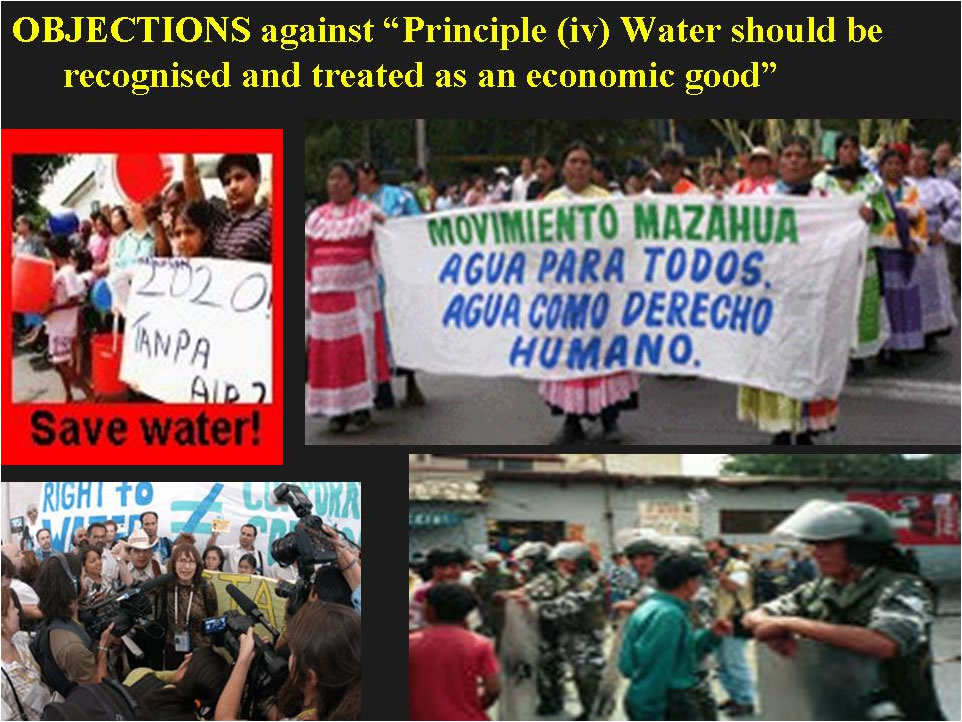
WORLD WATER FORUMS & WATER AS A HUMAN RIGHT
•1st WWF (Marrakesh, Morocco 1997), 2nd (The Hague, Netherlands 2000) & 3rd (Kyoto, Japan 2003), the World Water Council refused to recognize water as a right, instead arguing that water is a human need
(i)The terminology has shifted over the years from "privatization of water services" to "public-private partnerships"
(ii)More recently, in Mexico City (4th World Water Forum) privatisation of the water sector has been masked as "private sector participation."
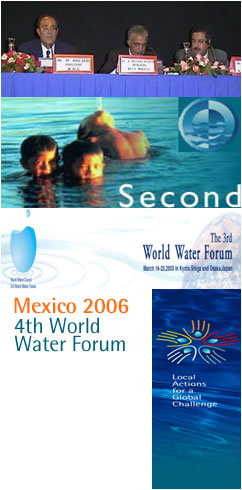

HOWEVER, WATER IS ONLY “FREE” IF YOU HARVEST IT YOURSELF. DO NOT EXPECT H2O TO BE TREATED & PIPED TO YOUR HOUSE FOC!

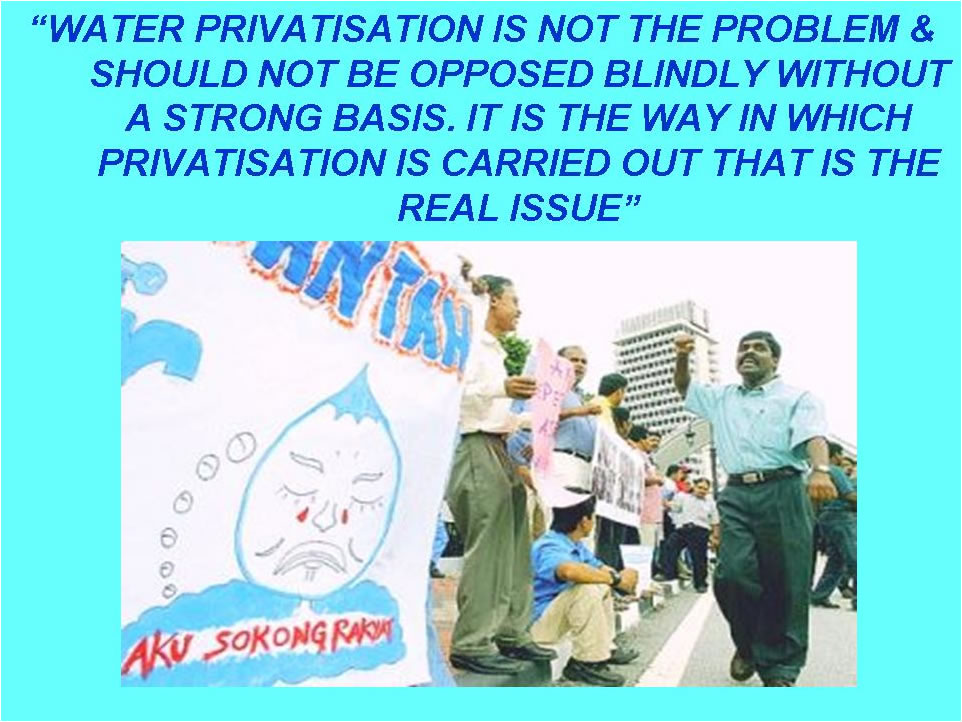
SUMMARY: WATER - A SOCIAL OR ECONOMIC GOOD?
•Water means different things to different people
•Perception, use and water supply are the main questions
• There are both successes as well as failures in considering water as an economic good
• Consumers are willing to pay a reasonable price for efficient and reliable service
• Public cannot accept governments to relinquish its water resources to foreign powers
2.3 Role of water in determining social equity and human dignity with discussion on the philosophical/conceptual model for Values-based Water Education
•Treating water as an economic good is a threat to social equity
• If different groups in society have different access to water, then there is social inequity
• When water is expensive & denies the poor of access, it creates social inequity
(i) Where is human dignity when one gets to have a wash of one’s body with limited dirty water only once in a month?
(ii) Where is human dignity when children have to collect water from drains and polluted rivers to be used for their daily needs?
(iii) Where is the human dignity when families are on starvation when drought hits their farms?
SOCIAL EQUITY
•Definition: “The fair and equitable access to opportunities, livelihood, education, and resources; full participation in the political and cultural life of one’s community/country; and self-determination in meeting one’s basic needs”
• When there is no social equity, there would be injustice
•Social equity & Communism
•Social equity & Democracy
•Social equity must be achieved in all countries to ensure equitable share of the wealth
• Inequity is the major problem in democratic societies
3.0 Water, human dignity & social equity with integration in HVWSHE curriculum
3.2 Management of water resources with the roles & involvement of government & NGOs
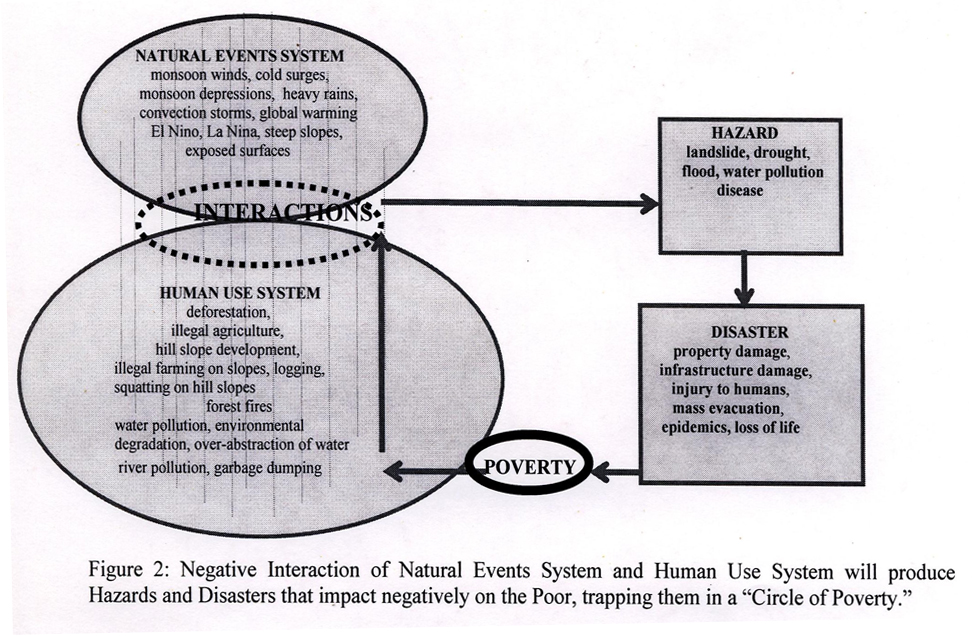
ROLE OF NON-GOVERNMENTAL ORGANISATIONS IN WATER GOVERNANCE
• NGOs important in achieving social equity
• In the past, NGOs were looked upon as “Anti-Development” but now “Partners”
• Role lie in public awareness, conservation, protection and education
• “Watch Dogs” over water tariffs, water pollution, contracts, privatization etc
• “Water Saving Society”
• Contribute towards sustainable development of water resources
- • Direct management of water resources.




![]()
•Involvement of civil society and NGOs lead to transparency and accountability
• NGOs bring about more effective water management
• NGOs bring about affordable tariffs
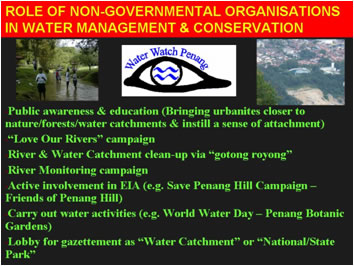
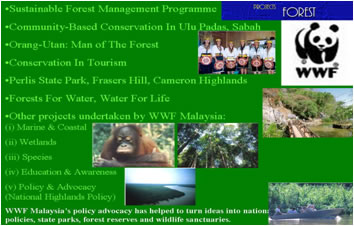
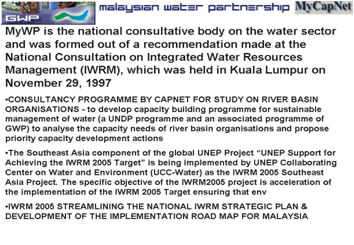
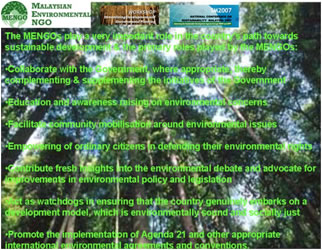
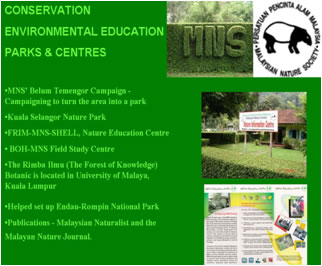
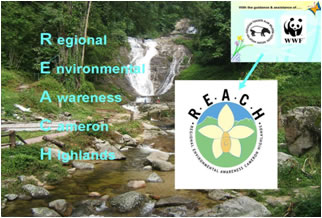
3.2.1 Water resources management models: State centred, private sector driven and public-private-partnerships
Models of water resources management:
(1)State Centred Model (wholly owned & managed by the state, or otherwise known as “Government Managed Model”)
(2)Privatisation Model (private sector driven model based on the principle of the free market and theoretically driven by market forces of supply and demand)
(3)Public-Private Partnership Model (models that feature a combination of shared management between government, industry, NGO and the public (Local Communities)
History of Water resources management models
Historically, most countries manage water via governments
* Privatization is relatively new
* Currently, only 5% of the world’s water services are run by private companies
* In the past, private companies have shunned water services because of perception that there was little or no profit to be made
* However, as the world becomes drier privatization of water has become a norm
* Water is now perceived as “Blue Gold” & this has motivated MNCs to move into a very attractive "water market."
(i) State Centred Model (wholly owned and managed by the state, or otherwise known as “Government Managed Model”)
•Traditional model in most countries for much of the 20th century
• Governments owned & run the water supply on a subsidized basis
• Water was regarded as a public service, by municipal governments
• Government control based on Economics & Ethics – (i) Drinking water was necessary for health; and (ii) Infrastructures was costly
• Governments Corporations set up to operate the water supply, but they were non-profit and still managed by government servants
SUCCESS STORIES OF STATE-MANAGED MODEL

(i)World’s largest public water utility based in Sao Paolo
(ii)Supplies water to more than 22 million
(iii)Company with open capital & main shareholder State Government of São Paulo
(iv)Responsible for planning, construction & operation of the water systems
(v)Satisfy needs of the population and environment
(vi)800 production units and massive distribution networks
•Hyderabad Metropolitan Water Supply and Sewerage Board (India)
• National Water and Drainage Board Water and Sanitation project (Sri Lanka)
Public Utility Board (PUB)
![]()
•Singapore’s PUB is one of the best managed in the world (www.pub.gov.sg)
• Singapore Government has full control of PUB
• IWRM
• Lowest NRW rates between 10 to 15 %
• Low Per Capita Consumption = 165 LPCD
• Limited water resources (152 m3/capita/yr)
• Catchment Protection – 50% total land set aside as catchment
• Imports water from Johor, Malaysia
• New technologies - “NEWater” & Desalinated water
• Addition (New Sources) & Multiplication approach (Reclamation)
PERAK WATER BOARD (PWB) is a model of a Government Managed Model (GMM)
• Under control of the Perak State Government (Figure 3)
• Profits: RM39 m (2002); RM47 m (2003); RM27.39 m (1st half 2004); RM54 m (2005); RM75.39 m (2006); 2009 Target = RM100 m
• PWB;s NRW is about 30 % (Target reduction to 20% by 2010)
• Competitive Tariffs
• Re-Investments
• New Dams & Treatment Plants
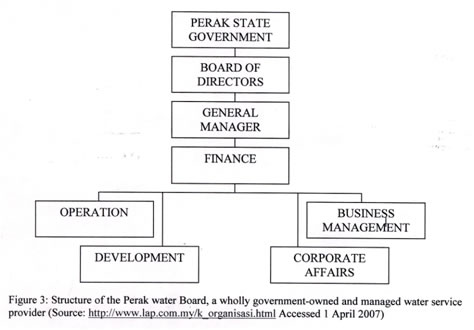
(ii) THE PRIVATISATION MODEL
• CHANGING SCENARIO
PROS & CONS OF THE PRIVATISATION MODEL
(i)It is a way of reducing public expenditure
(ii)improving efficiency and services
(iii)increasing profitability
(iv)energizing the economy, boosting productivity & creating more jobs
(v)transferring of technology from foreign multi-nationals
(vi)achieving greater effectiveness and cost reduction
•However, equally, there are many disadvantages:
(i)Seen s the inability of government to manage the privatized resource/service
(ii)Seen as government giving up its responsibility to serve the people
(iii)Seen as a form of neo-colonialism
(iv)Seen as exploitative and a way of impoverishing poor economies
(v)NGOs argue that privatisation is closely related to cronyism & corruption
(vi)Seen as a threat of denying access to the poor
(vii)Seen as a way of increasing tariffs.
WATER PRIVATISATION EXPERIENCES IN MALAYSIA
There are more cases of failures in privatization of water resources in Malaysia than there are successes
•SABAH is deep financial crisis (By the end of 2002, the state owed RM524mil to three water concessionaires)
•KELANTAN - Thames Water of London and the State-owned Kelantan Darul Naim Foundation failed miserably
•INDAH WATER KONSORTIUM (IWK) - The Government had to buy back IWK from Prime Utilities Bhd for RM192.54 million early 2000 (IWK was awarded the sewerage treatment and management services in 1994)
•Perbadanan Bekalan Air Pulau Pinang Sdn Bhd (PBAPP) Listed on the KLSE. Appears successful (State still holds majority of shares, State Water Supply Dept controls PBAPP,
![]()
![]()
![]()
(iii) Public-Private Partnership Model
•A combination of shared management between government, industry, NGO and the public/Local Communities
• PPP Model is an alternative in between Government, Privtae Sector, NGO & Local Communities
• Welsh Model - passed from central government to private & to a non-profit private company owned by its members
• Variations of the PPP Model
PUBLIC-PRIVATE-PARTNERSHIP IN GHANA
• Partnership between (i) Ghana Water Company, (ii) Savelugu township and (iii) Local Communities
•Introduced as part of an overall program to restructure the water sector in the early 1990s to address deficiencies in the sector
Management Contract with Ghana Water Company Ltd:
•Community responsible for pricing, distribution & infrastructure maintenance
•Community is given a greater role in management and is able to negotiate with the company on behalf of its members
•Equitable water access achieved, decision-making totally transparent & those who cannot afford to pay for water were exempt from any cost
PPPs IN THE USA
• Tolt Water Treatment Plant (Seattle)
• PPP between American Water and the City of Buffalo
• San Juan Capistrano
• All these cities were all provided high quality services in repair & maintenance of the distribution system
• Partnerships between municipalities and the private sector is workable
SUMMARY OF PPPs
•The success stories of PPPs in the UK, Africa & USA show that this model is not only for the developing world but in fact serve many communities in the developed countries. Today, PPPs are operating successfully at local, state and federal levels
(i)government has the finances or ability to raise funds
(ii)the private sector has the expertise and know-how
(iii)government remains in control in a PPP unlike in full privatization
(iv)citizens are confident of PPP and give their support
(v)there is efficiency and good performance indicators
(vi)tariffs remain under control
(vii)government & private sector funds combined is substantially larger
(viii)healthy competition between both government and private sector
(ix)difficult water issues get solved by innovative solutions
(iv) COMMUNITY MANAGED MODEL
•Wholly managed and sustained by local communities, but often initiated and supported by donors (either foreign or local)
•Most appropriate at the local/village level
•Many examples of successful CMM in the developing countries
(i)Champions
(ii)NGOs
(iii)Cooperation from Government
(iv)Support of Donors
(v)Local Expertise & Foreign Expertsie
(vi)Local Labour/Workforce
(vii)Affordable Technology
(viii)Simple & Uncomplicated Technology
(ix)Local Raw Materials
(x)Involvement of Locals
(xi)Ownership of Locals
(xii)Other Factors
COMMUNITY MANAGED MODEL IN CHILE
(i)Fog Harvesting in Chungungo
(ii)1987, 50 large fog collectors (each 48 m2) of polypropyrene mesh constructed
(iii)Fog collectors generate > 3 litres/m2/day, or 10,800 litres/day
(iv)Ranges from 0 litres (fogless day) to a max of 100,000 litres (foggy day) per day
(v)Each villager now receives about 33 litres/day, more than double their previous water use
(vi)A “Potable Water Committee” (PWC) of elected villagers and other voluntary unpaid members operate the system

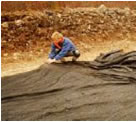

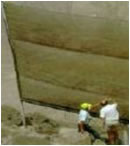
YEMEN – CWM FOG COLLECTION PROJECT

•The project started in January 2004 (FogQuest & ICS [NGOs] & Local Communities)
• 25 large fog collectors (LFCs) were built
• The water from each pair of LFCs goes to a 1 m³ galvanized metal tank
• The production rate from a pair of LFCs is 360 L of water per day in the winter dry period, sufficient for 36 people at a subsistence level
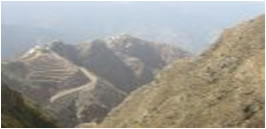
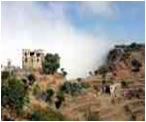
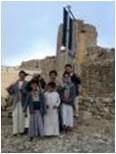

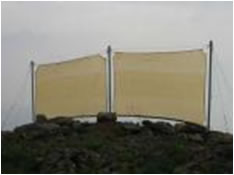
SAVELUGU COMMUNITY WATER MANAGEMENT
• In Savelugu (Ghana) the community is totally responsible for pricing, distribution & infrastructure maintenance of water
• Community plays a very important role in management and is able to negotiate with the water company on tariffs, new schemes, access, exemption for the poor, etc
• The community controls the water management and ensure equitable access by all members of the community
• This model guarantees the transparency of popular decision-making
RAJ SAMADHIYALA, RAJKOT DISTRICT, GUJARAT (INDIA)
INITIATION OF WATER HARVESTING: 1986
•1985, 2000 people faced a major water crisis as groundwater table had dropped to a depth of 250 m
•Villagers started to build check dams & tanks
•2001, 400 mm of rainfall while in 2002, even with no sign of rain, water is available at a depth of 15 m
RAJ SAMADHIYALA: WATER BENEFITS
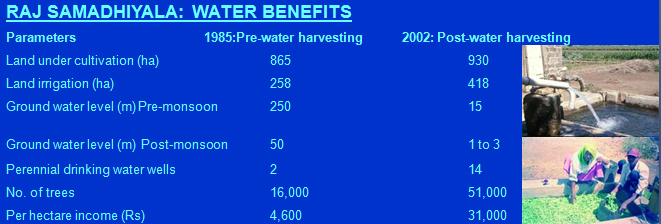
VIETNAM - PHOUC KIEN POOR COMMUNITY

• Local community & NGOs manage own clean water supply
• System is planned, implemented and operated by the community
• 107 households now benefit from the system
• Beneficiaries get clean water from the tap in their homes
• The system operates 24 hours a day
• The water bill of households have also dropped significantly to half
• Local people are employed in the system as labourers
• Local people are trained and become skilled in water services
• Gender Equality
INDONESIA
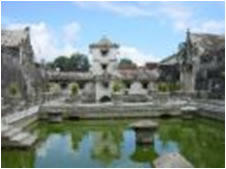
• Northern Code community in Jogjakarta manage the water delivery system
•1991 no piped water, but by 2006, Northern Code community in Jogjakarta has water piped to about 115 households
(i)strong leadership
(ii)strong sense of solidarity amongst the community
(iii)sense of belonging as the community
(iv)economic development was important.
CONCLUSION
•Water is a basic human physiological need that must be satisfied before other needs (5 LPCD is needed for to stay alive & 50 LPCD for all purposes, Malaysians use too much)
• The progress of human civilisation has been phenomenal, but the irony is that many basic human needs (e.g. water) are not equally accessible to all
• Water is intricately inter-woven into the fabric of all cultures, religions and lifestyles of all societies in myriad ways
• Many covenants and international agreements on human rights but none specifically relate to water (though water as a human right is “acknowledged”)
•Water can be viewed as a human right and as an economic good. Both has pros cons. It is how humans treat water that matters, not how we view it
• Privatization is “feared” by NGOs but championed by MNCs as a panacea for all our water woes. Problem is not privatisation but how it is carried out
• Government-Owned Model, Privatisation Model, PPP Model & Community WMM
• Water has a role in determining social equity and human dignity
• Effective IWRM cannot be achieved via a “Top-Down” or “Bottom-Up” approach but by a “Horizontal” approach with active involvement of Government, Private Sector, NGO & Local Communities (Public)